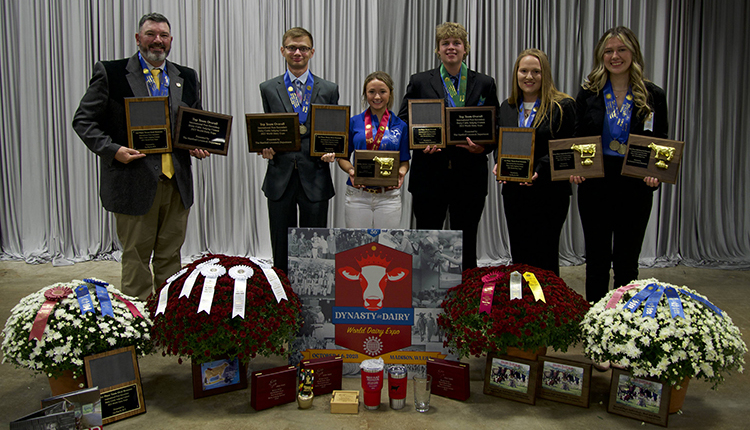"Alfalfa and grass aren't the same, but they can be complementary to each other," noted Jim Paulson with the University of Minnesota. Paulson along with Paul Peterson, University of Minnesota, shared results from their on-farm evaluation of alfalfa-grass mixtures.

Peterson started off the presentation noting that nature has it figured out; diverse stands tend to do better than monocultures. "Forage mixtures of alfalfa with perennial cool-season grasses offer whole-system advantages over alfalfa monocultures."
Their research assessed forage yield, quality, and species compatibility of alfalfa/grass mixtures versus alfalfa monocultures on three Minnesota farms. At the conference, they focused on the two sites in their third production year (Underwood and Hutchinson, Minn.). Perennial grasses included meadow bromegrass, smooth bromegrass, festulolium, meadow fescue, tall fescue (TF), perennial ryegrass (PRG), orchardgrass (OG), reed canarygrass, and timothy.
The alfalfa/tall fescue (ALF/TF) mix at Underwood, with a season average of 31 percent grass, was the top total-season yielder (5.87 tons dry matter per acre). This combination produced 20 percent more DM than alfalfa alone (4.89 tons dry matter per acre). Alfalfa mixed with meadow bromegrass, timothy, meadow fescue, or orchard grass ranked second behind ALF/TF, yielding about 7 percent less DM. ALF/OG stood alone with the greatest season-average grass content with over 50 percent. In the third production year, ALF/PRG had the least grass.
At Hutchinson, ALF mixed with either OG or TF were the top total-season yielders, producing 12 percent more DM than ALF alone. ALF/OG (4.03 tons dry matter per acre) also had the greatest grass percentage, while ALF/TF (4.01 tons dry matter per acre) ranked second. ALF/FL was the only other mixture to outyield ALF alone by 7 percent and ranked third in grass content.
Taller stubble height needed
They also noted that growers who harvest and leave a 2-inch stubble height might struggle with grass regrowth and persistence in the stand. "Three to four inches of stubble is needed when grass is in the mix. When grasses don't have enough of a crown, photosynthesis becomes difficult and they are not able to compete," added Peterson.
If the decision is made to include grasses in the mix, producers need to find the better ones that are available. They need to look into the varieties and ask questions until they find what will work best on their operation. Paulson also noted that ration software often overestimates milk production for high-grass diets. This fault may be a shortcoming of the information provided to the model.
Finally, Paulson noted, "We aren't paid on the pounds of milk that go down the road. We are paid on the protein and fat content of our milk. Maybe it is time to shift our thinking about what we are taking off an acre of ground." He suggested a focus on the crude protein and neutral detergent fiber content of forages with a continuing look at NDF digestibility.

Peterson started off the presentation noting that nature has it figured out; diverse stands tend to do better than monocultures. "Forage mixtures of alfalfa with perennial cool-season grasses offer whole-system advantages over alfalfa monocultures."
Their research assessed forage yield, quality, and species compatibility of alfalfa/grass mixtures versus alfalfa monocultures on three Minnesota farms. At the conference, they focused on the two sites in their third production year (Underwood and Hutchinson, Minn.). Perennial grasses included meadow bromegrass, smooth bromegrass, festulolium, meadow fescue, tall fescue (TF), perennial ryegrass (PRG), orchardgrass (OG), reed canarygrass, and timothy.
The alfalfa/tall fescue (ALF/TF) mix at Underwood, with a season average of 31 percent grass, was the top total-season yielder (5.87 tons dry matter per acre). This combination produced 20 percent more DM than alfalfa alone (4.89 tons dry matter per acre). Alfalfa mixed with meadow bromegrass, timothy, meadow fescue, or orchard grass ranked second behind ALF/TF, yielding about 7 percent less DM. ALF/OG stood alone with the greatest season-average grass content with over 50 percent. In the third production year, ALF/PRG had the least grass.
At Hutchinson, ALF mixed with either OG or TF were the top total-season yielders, producing 12 percent more DM than ALF alone. ALF/OG (4.03 tons dry matter per acre) also had the greatest grass percentage, while ALF/TF (4.01 tons dry matter per acre) ranked second. ALF/FL was the only other mixture to outyield ALF alone by 7 percent and ranked third in grass content.
Taller stubble height needed
They also noted that growers who harvest and leave a 2-inch stubble height might struggle with grass regrowth and persistence in the stand. "Three to four inches of stubble is needed when grass is in the mix. When grasses don't have enough of a crown, photosynthesis becomes difficult and they are not able to compete," added Peterson.
If the decision is made to include grasses in the mix, producers need to find the better ones that are available. They need to look into the varieties and ask questions until they find what will work best on their operation. Paulson also noted that ration software often overestimates milk production for high-grass diets. This fault may be a shortcoming of the information provided to the model.
Finally, Paulson noted, "We aren't paid on the pounds of milk that go down the road. We are paid on the protein and fat content of our milk. Maybe it is time to shift our thinking about what we are taking off an acre of ground." He suggested a focus on the crude protein and neutral detergent fiber content of forages with a continuing look at NDF digestibility.








